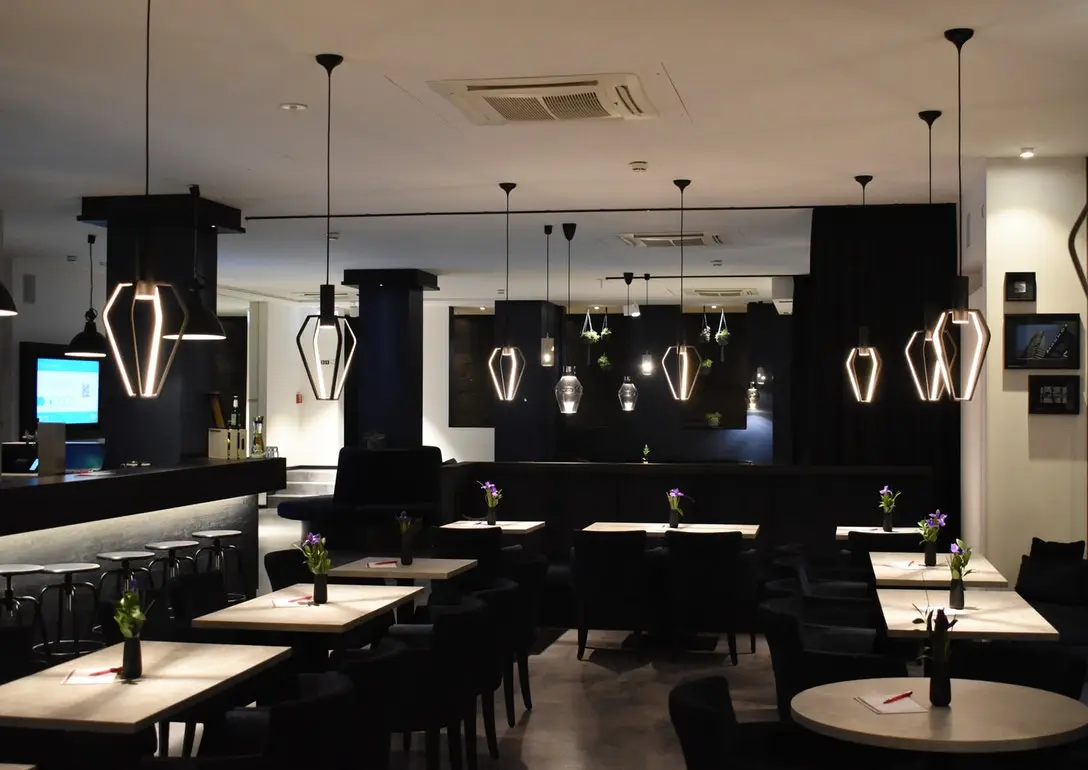The restaurant industry is fast-paced and competitive. Your success is dependent on many factors, all of which are associated with how well your business evolves. Without introducing changes, you may experience dropping sales, fewer customers daily, or a lack of new interest. Rebranding your restaurant may be one of the best ways to freshen up your look and bring back the excitement.
However, rebranding a business takes time, money, and energy, so you need to be sure you’re prepared to take on such a project. You’ll also need to know what steps to take beforehand. This guide covers how to rebrand your restaurant and provides eight tips for successful restaurant rebranding as well as all the details you should upgrade.
The Importance of Rebranding Your Restaurant
Managing your restaurant takes a significant amount of attention. The journey of turning your business idea into a reality and creating your own brand is emotional. It’s easy for any restaurateur to get attached to their creation like it’s their baby. However, that attachment can be detrimental when it comes time to let go of the original ideas and make changes.
Restaurant rebranding focuses on the customer base to create an experience and identity that’s memorable and positive. To truly succeed at a rebrand, you need to understand the details that drive customers to choose your restaurant — or not. By paying attention to trends, competitors, your guests, and your successes and shortcomings, you can get your restaurant back on track and enjoy the benefits of your branding.
If done correctly, you and your team will:
- Increase sales: Rebranding allows you to hold on to your current customer base while creating intrigue that will attract new visitors. If your restaurant feels outdated or your customers are used to a pricing structure and menu, it may prevent you from competing with rising food costs. A rebrand allows you to reshape the public perception of your restaurant, which translates to an associated price range. The more modern and chic your theme, the higher you can price your menu items.
- Attract top talent: With the rise of social media, people’s names are becoming their brands. The same applies to restaurant talent as well. Think of how many chefs, mixologists, and hospitality managers are known by name and associated with restaurants rather than identified by them. If you create a brand that top talents can align themselves with, you’ll attract a new class of staff.
- Improve public relations (PR): Contrary to the popular saying, not all PR is good PR. Negative attention can bring your brand down in value. On the other hand, good PR can elevate your name and win over consumers. Positive reviews and articles often serve as a first impression — one that may convince future regulars to give your restaurant a try in the first place.
- Benefit from an updated look: Unless your restaurant is an authentically retro 24/7 diner, having an outdated look is not suitable for business. Even if you’re trying to emulate an era, you need to meet the expectations of modern consumers. When you rebrand, it’s new and exciting, which grabs the attention of customers. As long as you back up an updated interior look with the same level of marketing, specialty menus, and service, you’ll bring in more business and encourage visitors to return.
Most importantly, a rebrand will help you be better equipped to contend with — and beat out — your competition. You may even convert some competitors’ customers to yours. Keeping your restaurant contemporary in terms of marketing style, interior design, food and drink programs, events, and services will put you at the top with the latest restaurants in your area.
Tips for Launching a Successful Restaurant Rebrand
If you’re going to rebrand, you have to go all-in. Learn about all the steps involved, figure out the best course of action for your business, and update everything cohesively and within the same period. It’s hard work, but as long as you make a plan before you begin, you can accomplish a thorough restaurant rebrand.
Here are some of the best tips for rebranding your business:
1. Understand Your Restaurant
The most important place to start is with the current state of your restaurant. From the customer base to the menus, you need to have a baseline to compare with post-rebrand. See what your guests and staff like or don’t like about the decor, theme, food, drinks, service, or anything else they want to share. Take the personality and attitude of the space into account as well.
To fully comprehend where you’re starting and where you want to go, spend some time reflecting. Think about where you’d like your business to be after the restaurant rebranding and set specific goals. Consider which areas need the most time and attention. Examine your current values and mission and make changes to embody what you want for the future.
When it comes time to implement changes, understanding where you stand and what you need for success will be exceptionally helpful. Starting with the right outlook will set the tone for the rest of your branding strategy.
2. Know Your Audience
Just as you should know your restaurant, you should also be aware of your audience. This doesn’t just mean your regulars either — while you’ll want to keep them, you likely also want to expand your consumer base. Consider the locals and what demographics make up the majority of the nearby population. Your aim should change depending on who your largest prospective group is, from age to gender to median income.
Your audience also includes other successful restaurants nearby. They’ll be watching your moves and trying to compete for customers, so you need to bring them into the equation as well. Think about ways you can make your restaurant rebranding more appealing to the broader demographic.
3. Check on Competitors
It’s crucial to analyze how your restaurant branding stacks up in comparison to your competitors. If you know where you stand among the other restaurants in your area, you’ll have the benefit of knowing what you need to change to surpass them. You should conduct a SWOT analysis — a measure of your business’s strengths and weaknesses, possible opportunities, and threats from other restaurants.
When you analyze each of these elements, here’s what you should focus on:
- Strengths: Recognize the areas where your restaurant performs best, whether it’s food, cocktails, service, specialties, ambiance, or any other element. While growth is all about improving, you need to acknowledge where your business excels. If your bartenders are top-notch, you may want to focus on that in your marketing and branding. If customers love certain aspects of your decor, consider incorporating it into the new design.
- Weaknesses: Identifying where your restaurant is weakest will help you focus on where you can make the most significant improvements. For example, if you know your servers struggle with table layouts or the current seating system is hurting service, you can create a better floorplan. Your staff and customers should benefit from the changes.
- Opportunities: A rebrand is a perfect time to take advantage of open opportunities. Look for ways you can expand physically or through delivery services, change the menus, or do something no one else in the area is doing. Additionally, you can look at how your competition has been modernizing, then get ahead by adding your spin.
- Threats: Keep an eye on competing restaurants and new openings around your area for potential threats that could affect your business. The restaurants in your area are vying for the same customers you are — especially if they have a similar theme or menu Also, pay attention to the rising prices of regional foods. If a particular ingredient is getting too pricey, you may want to consider replacing it in your new menu.
All these details will help you meet your goals. You’ll have a better restaurant individually as well as in comparison to others.
4. Take Feedback Seriously
Customers are frequently willing to give feedback. They often do so unprompted, especially if they’ve had a particularly positive or negative experience. Their opinions can be valuable — they’ll tell you exactly where you need to step up your game and what you should keep doing. Gather as much feedback as possible before the rebrand planning and take it into account.
You can collect customer suggestions and comments in several ways. One of the most direct ways is talking to the tables once they’ve finished their meals. This method also has a secondary benefit — when a manager makes sure customers have a good experience, the restaurant seems more personable and caring. You can also ask them to fill out a survey or prompt them to respond to social media posts and polls.
5. Involve Your Staff
When it comes to planning a restaurant rebranding, sometimes the staff is overlooked. However, their thoughts, suggestions, and concerns matter significantly. They’ll be the ones on the front lines after the rebrand — make sure they’re comfortable with the changes. If you let them participate in the planning, they’ll be excited to see their ideas in the relaunch. Each staff member also has a unique perspective when working.
Your servers and bartenders spend the most time with the customers and will naturally hear more feedback than anyone else. Bartenders also have the most experience with your drink menu, so they can vouch for which items you should cut or keep. The same goes for the cooks, who can tell you the most popular items and how to style the new dishes.
6. Revise the Menu
When you’re rebranding a restaurant, you need to provide new food and drink menus. If you overhaul the branding but leave the menus the same, customers are bound to be confused. The biggest motivations for guests are the food and drinks you serve, more so than the ambiance or logo. While the new look may be effective at attracting more customers, the menus are what will keep them coming back.
Think simple but effective. You don’t need a wide variety of options if what you serve is excellent. Having a one-page menu of beautifully crafted dishes is far more appealing than a five-page menu of average choices. You should also keep the menu design and pricing consistent with your ambiance. Even the way you list items and prices is a form of branding. For example, classier and more modern restaurants use a flat number — no cents, no dollar sign.
7. Focus on Marketing and Branding
Advertising is one of the most significant areas of a rebranding strategy. If no one knows about your renovations, they won’t be as effective at drawing in new customers. When you’re revamping your marketing tactics, you should:
- Make a plan: When planning your rebranding as a whole, include a marketing strategy. Think about the types of advertisements you want to use, how you are going to design them, and how much you want to reveal. Sometimes, leaving a little mystery is a great attention-getter.
- Use social media: Whether your restaurant already has an established social media presence or is just beginning, a rebrand is a perfect time to use it to your benefit. You can engage with customers, get them excited for the reveal before your launch, and get feedback after. It’s also a great way to get in some free advertising by releasing dates and times, posting pictures or videos of menu items, and creating a teaser for the reopening party. Keep in mind that customers who have engaged with your restaurant on social media will likely spend 20% to 40% more when they order.
- Revamp your logo: Your logo represents the entirety of your brand. When you renovate, you need to alter your logo to make it fit in cohesively. It’ll likely be one of the first changes customers will notice and may prompt them to see what else you’ve revamped. Just be sure not to change it too often, as that comes across as a sign of unreliability.
- Revise your style: If you try to rebrand without overhauling the physical space of your restaurant, your marketing may not work as well as you want. Even if you love a specific part of the decor, a full style change is more beneficial for your business than holding on to old or outdated design elements.
When you’re considering digital marketing solutions, some of the top options include Facebook, Instagram, and Google My Business. Creating an active Facebook page will give you access to a large consumer base and allow you to interact with and reward customers. Instagram is the best site to take advantage of the food photography trend to boost your visibility and show guests what they can expect from your chefs and bartenders.
Google My Business is all about getting in on search engine optimization (SEO). With an effective SEO strategy, you can ensure customers see your business in their search results. With about 46% of Google searches focused on finding local listings, you should consider using the engine’s features for your restaurant.
Changing your marketing strategy and rebranding go hand-in-hand — one without the other is far less effective than doing both together. The more cohesive everything is, the better your chances of succeeding with a rebrand.
8. Host Special Events
A dramatic reopening celebration is a great way to catch the attention of locals and new visitors. Rather than quietly open your doors and allow people to see the new restaurant whenever they come in, schedule an unveiling event. When choosing a date, check community calendars to be sure it won’t coincide with other activities and pick a time that’s convenient for a notable amount of people.
If you put in a decent amount of advertising effort, you’ll likely have a busy opening night. Consider offering only a few of your best food and drink options at your reopening event. This will help the night run smoother, and it’ll keep your customers curious about what the full menus look like, prompting them to come back.
A rebrand is no easy task. But with the right tools and assistance, you can build your path to a successful future.
Improve Your Management With Mad Mobile
With Mad Mobile, you can boost your efficiency, organize and manage operations with your staff, and keep your customers happy. Our solutions will help your team flourish, and a rebrand is a perfect time to incorporate new restaurant technology into your business. Take on the day-to-day processes with ease and make management stress-free with our tools, including:
- Point of Sale (POS): Your POS system is an essential tool and can help or hurt your efficiency. Our simple and intuitive system will help you manage your orders and sales, complete with affordable hardware and software, 24/7 customer support, and transparent pricing. With stationary and portable touchscreens, you and your staff will stay connected and improve customer service from anywhere in the restaurant.
- Guest Management: Our Guest Management system allows you to keep a more organized account of reservations, walk-ins, no-shows, servers’ table responsibilities, and waitlists. You can also text your guests when their table is ready, and they can keep tabs on their wait time without having to stick around. It’s efficient, easy to use, and optimizes the way you work.
- Online Ordering: Restaurants that offer an online ordering system to their customers typically receive 32% more orders than those that only accept orders by phone. Online ordering adds to your revenue while still leaving space for more dine-in guests. Your staff won’t have to break their attention to take phone orders. Customers love it, and your servers will too.
If you’re planning to rebrand your restaurant, start by improving the way your business runs with Mad Mobile. Contact us for a free demo today.





